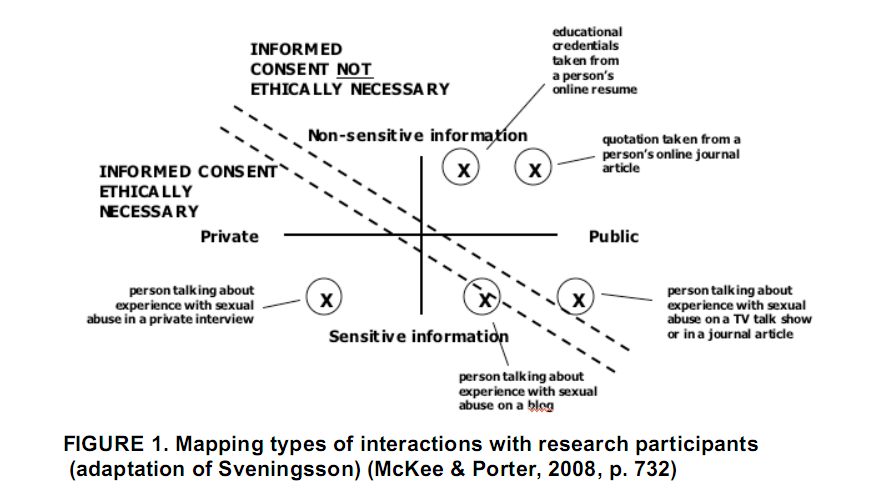Activity 13.4: Reading 16 (2.5 hours)
Read Gillen's paper in full.
- To what extent do you think the "new synthesis of methods" (p.72) is actually new?
Gillen uses the term 'virtual literacy ethnography' for her 'new synthesis of method'. I am not sure that they really are new methods or even a new collection of methods as she says that "I aim to explore the range of literacy practices...." (p.57) but then goes on to say that there was only "a tiny amount of speech in-world" (p.59) and that conversation was mainly written, the forum was written and all the material on the Wiki that she describes is also written. She does mention 'multi-modality' (p.69) in connection with Wiki but this is not analysed or even discussed. Julie Coiro has published some interesting things on new literacy practices including being one of the editors of The Handbook of Research on New Literacies where literacy is discussed as a constantly evolving medium where the author has to make choices about which forms and functions most suit their purpose. Gillen appears to have restricted the analysis only to the traditional analysis of language used although she also comments on collaboration
The method does not seem to address the aim as it only analyses the written word with a frequency list of words drawn up and compared to newspaper articles, correspondence and everyday adult conversation - very different conversation forms to that used when encountering another young person's character in SL.
- Would your methods have been any different?
I would have liked to explore the young people's choice of the literacies available to them. Lawrence (2005) discusses the use that young people make of slices of digital animation, video and audio in their literacies. In order to examine this complex field, the researcher needs a framework to give the structure and order required to examine literacy from diverse perspectives and I am currently uncertain how I would do this but I am inclining towards Activity Theory as it looks at the temporal dimension of the activities as well as the tool, context etc.
Looking at a single issue, I think I would have liked to examine the support networks that the students set up between themselves in order to develop their literacy practices. For example, Gillen illustrates the literacy of the group by referring to the setting up of the dictionary. I would be interested in how this was done: how they chose and defined the terminology; how they negotiated the methods by which they wrote the definitions. This collaborative aspect of new technologies intrigues me as I work with many young people with Asperger Syndrome who find it very difficult 'letting go' of their work when it needs to go towards a group project.
- How does Gillen's approach relate to the account of ethnography provided by Hammersley in Reading 15? Can the research be considered an ethnography?
I do not consider this work to be a true ethnography. Hine (2000) defines ethnography as 'a researcher spending an extended period of time immersed in a field setting, taking account of the relationships, activities and understandings of those in the setting and participating in those processes' (see activity 13.1 for ref.). Gillen has spent time in-world but does not seem to have taken full part in forums and the Wiki and although she joins in, she is a staff member and researcher and the chat log extract seems to show that the main members of the group tolerate and carefully instruct her in simple tasks, much as an adult is allowed to join in children's games. The analysis concentrates on only one aspect of the activities - the language used, where true ethnography would examine the relationships, context and perceptions of those using the environment.
- What do you think of the researcher's avatar having the message "logging chat" above her head?
It marks her out as different and allows others to avoid her if they do not want their chat recorded. This is great from an ethical point of view but not so beneficial to research. In a simplistic view, ethics generally considers online information to be considered as public if it can be accessed openly by anyone with an internet connection or if the participant understands that it is public. The 'logging chat' logo is intended to inform participants that their conversation is public.
- Given the limitations of space, the discussion of ethics in the paper is brief, but you will have come across other papers about researching Second Life in earlier weeks. Try to list the key ethical issues for such research.
Informing the participants that the information they are sharing is public
Allowing participants more information about the research e.g. notecard (Rosenburg, 2010 p.26)
Quoting using a person's avatar name should be checked with person before publication
Simple observation cannot happen, researchers must participate so representation is important
I liked the diagram shown in McKee & Porter (2009) which allows for the researcher to use discretion to determine when informed consent is necessary:
